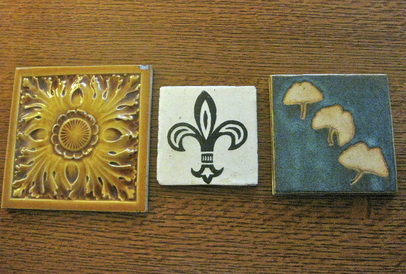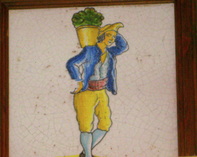- Welcome to The Wise Collector
- Knowledge Changes Everything!
- Buyer Beware!
- Buyer Beware!: Part II
- Caring for Your Antiques
- Coin Collecting
- McCoy Pottery
- Chinese Export Porcelain
- Frankoma Pottery
- The Arts and Crafts Movement
- Roycroft
- The Art Deco Period
- Susie Cooper Pottery
- Limoges China
- 18th C American Furniture Styles
- The Bauhaus School: Weimar 1919
- The Bauhaus School: Design & Architecture
- Portmeirion
- The End of a Century: Art Nouveau Style
- Biedermeier: The Comfortable Style
- The Souvenir Age
- A History of Ceramic Tiles
- Flow Blue China
- Collect Vintage Christmas Decorations
- An American Thanksgiving Through theYears
- How to Find an Antiques Appraiser
- Louis Prang, Father of the American Christmas Card
- Thomas Cook and the Grand Tours
- Harry Rinker's 25th Anniversary
- Mid-Century Modern
- Will Chintz China become Popular Again?
- Ireland's Waterford Crystal
- Vintage Wicker and Rattan
- Fishing Gear Collecting
- Bennington Pottery
- Identifying Pottery and Ceramic Marks
- The Art of Needlework in the Arts & Crafts Era
- The Delicious World of Vintage Cookbooks
- BLOG: RANDOM THOUGHTS
- E-BOOKS BY BARBARA BELL
- First Reader Consulting
A History of Ceramic Tiles
Tiles are all around us for everyone to enjoy. They are used in churches and mosques, restaurants and shops, hospitals and homes. Tiles cover walls and floors, roofs and pavements, furniture and stoves. They are often combined with other forms of ceramics such as terracotta, faience and mosaic.
Tiles are the simplest form of ceramic art. The earliest known examples are Egyptian and from 4,000 BC. Through history, tiles were made by Assyrians, Babylonians and the Islamic Empire. Early tiles can be seen in Tunisia (c.9th), Kashan Iran (c.11th), and many middle-eastern mosques display Koranic scripts using highly colored relief tiles (c.12th onwards).
In the 13th and 14th centuries Europe's churches were paved with decorated tiles. Holland was an important center for tiles in the 17th and 18th centuries and in the 19th century Britain pioneered mass-produced tiles.
The earliest tiles in Western Europe (late c.10th) were found in a number of locations in England (eg. York and Winchester). Glazed tiles were an expensive building item which resulted in their use being restricted to wealthy ecclesiastic establishments. From the 16th century onwards Moorish tile making slowly spread north through Spain. Some of the most spectacular ceramics can be found at the Alhambra Palace in Granada, and in the Great Mosque in Cordoba. From the14th century tin glazed tile making spread from Holland over to England.
In 1584 the first potters established themselves in the Dutch town of Delft. In just over fifty years, these potters secured a reputation for excellence and the city of Delft became famous as the place of characteristic blue-and-white earthenware. The industry flourished for a time, but with success came competition. By 1725 the Delft industry had begun to decline and many potters went broke. By the latter part of the 19th century only one earthenware factory survived in Delft: De Porceleyne Fles (the Porcelain Bottle). Two of the great European decorative traditions were Maiollica from Italy and Spain and Delft from Holland. When applied to ceramics these processes of tin glazing produced distinctive effects. The Maiollica tiles display a lively sense of colour and geometric design and, as the name 'pavimenti' suggests, were often used as flooring. Delft tiles however gradually grew away from flamboyant colour use and evolved the Chinese influenced blue and white style familiar today.
In the 19th century Britain pioneered mass-produced tiles. English tile making expanded rapidly during the industrial revolution, peaked in the late 1800s and slumped soon after the turn of the century. American tile makers enjoyed a similar period of prosperity to their counterparts but had to compete with English imports. The Arts & Crafts movement reinvigorated the handcraft of tile making, and it was used extensively in interiors for fireplace surrounds as well as wall decoration.
The trend at the turn of the 20th century toward more sanitary hygiene, led to the use of ceramic tile in kitchens and bathrooms. Even subways were lined with ceramic tile in often distinctive styles and colorful wall murals. The J. & J.G. Low Art Tile Co. in Massachusetts and the Rookwood, Grueby and Teco potteries in the Midwest became famous for art tiles utilized by architects such as Frank Lloyd Wright, H. H. Richardson, and the Greene brothers in California. Mexican clay tiles such as saltillo and talavera were used extensively in the Southwest as colorful accent inside as well as outside the adobe architecture.
Tiles are now much collected and studied. Tile making seems to be undergoing a revival at present. Architects, builders and individuals are taking a fresh look at tiles and how they can be used to enhance both interiors and exteriors of homes, public buildings and workplaces.
As collectibles, tiles are fascinating and can be a relatively inexpensive place to begin your hobby. One may specialize in tiles from a particular era, country of origin, color, subject matter, or maker. They are easily displayed in frames or incorporated into a wall or tabletop of modern tiles.
Interesting sites for further reading:
Tile Heaven
History of the Dutch [Delft] Tile
The Saltillo Tile Company, Santa Fe, NM and Mexico - wonderful examples of saltillo and talavera tiles
The Tile Heritage Foundation
Tiles are the simplest form of ceramic art. The earliest known examples are Egyptian and from 4,000 BC. Through history, tiles were made by Assyrians, Babylonians and the Islamic Empire. Early tiles can be seen in Tunisia (c.9th), Kashan Iran (c.11th), and many middle-eastern mosques display Koranic scripts using highly colored relief tiles (c.12th onwards).
In the 13th and 14th centuries Europe's churches were paved with decorated tiles. Holland was an important center for tiles in the 17th and 18th centuries and in the 19th century Britain pioneered mass-produced tiles.
The earliest tiles in Western Europe (late c.10th) were found in a number of locations in England (eg. York and Winchester). Glazed tiles were an expensive building item which resulted in their use being restricted to wealthy ecclesiastic establishments. From the 16th century onwards Moorish tile making slowly spread north through Spain. Some of the most spectacular ceramics can be found at the Alhambra Palace in Granada, and in the Great Mosque in Cordoba. From the14th century tin glazed tile making spread from Holland over to England.
In 1584 the first potters established themselves in the Dutch town of Delft. In just over fifty years, these potters secured a reputation for excellence and the city of Delft became famous as the place of characteristic blue-and-white earthenware. The industry flourished for a time, but with success came competition. By 1725 the Delft industry had begun to decline and many potters went broke. By the latter part of the 19th century only one earthenware factory survived in Delft: De Porceleyne Fles (the Porcelain Bottle). Two of the great European decorative traditions were Maiollica from Italy and Spain and Delft from Holland. When applied to ceramics these processes of tin glazing produced distinctive effects. The Maiollica tiles display a lively sense of colour and geometric design and, as the name 'pavimenti' suggests, were often used as flooring. Delft tiles however gradually grew away from flamboyant colour use and evolved the Chinese influenced blue and white style familiar today.
In the 19th century Britain pioneered mass-produced tiles. English tile making expanded rapidly during the industrial revolution, peaked in the late 1800s and slumped soon after the turn of the century. American tile makers enjoyed a similar period of prosperity to their counterparts but had to compete with English imports. The Arts & Crafts movement reinvigorated the handcraft of tile making, and it was used extensively in interiors for fireplace surrounds as well as wall decoration.
The trend at the turn of the 20th century toward more sanitary hygiene, led to the use of ceramic tile in kitchens and bathrooms. Even subways were lined with ceramic tile in often distinctive styles and colorful wall murals. The J. & J.G. Low Art Tile Co. in Massachusetts and the Rookwood, Grueby and Teco potteries in the Midwest became famous for art tiles utilized by architects such as Frank Lloyd Wright, H. H. Richardson, and the Greene brothers in California. Mexican clay tiles such as saltillo and talavera were used extensively in the Southwest as colorful accent inside as well as outside the adobe architecture.
Tiles are now much collected and studied. Tile making seems to be undergoing a revival at present. Architects, builders and individuals are taking a fresh look at tiles and how they can be used to enhance both interiors and exteriors of homes, public buildings and workplaces.
As collectibles, tiles are fascinating and can be a relatively inexpensive place to begin your hobby. One may specialize in tiles from a particular era, country of origin, color, subject matter, or maker. They are easily displayed in frames or incorporated into a wall or tabletop of modern tiles.
Interesting sites for further reading:
Tile Heaven
History of the Dutch [Delft] Tile
The Saltillo Tile Company, Santa Fe, NM and Mexico - wonderful examples of saltillo and talavera tiles
The Tile Heritage Foundation
Web Hosting by iPage. The copyright of the articles in The Wise Collector is owned by Barbara Nicholson Bell. Permission to republish any articles herein online or in print must be granted by the author in writing.


